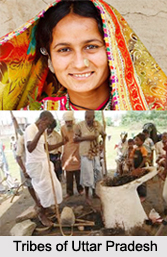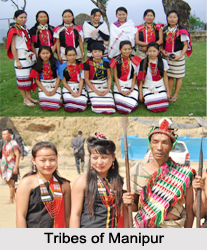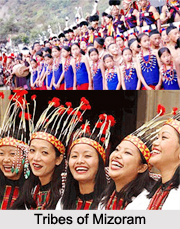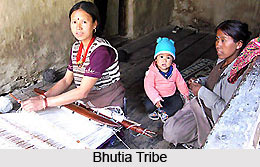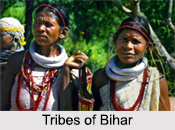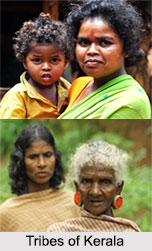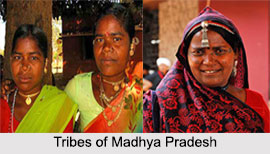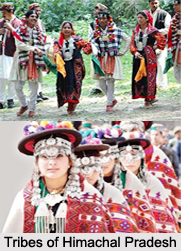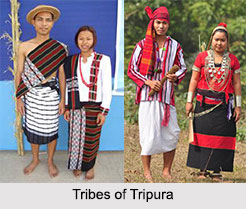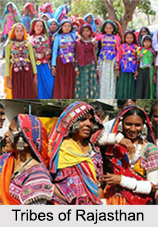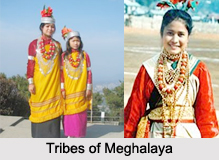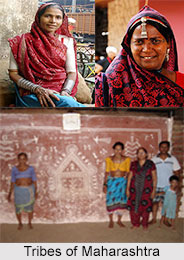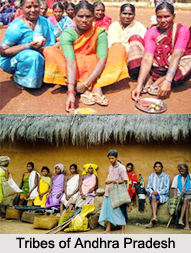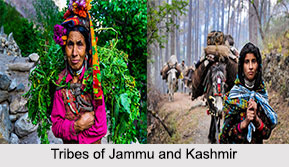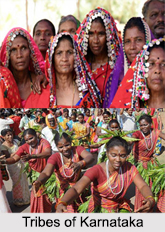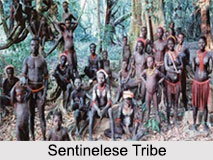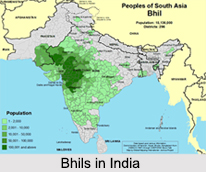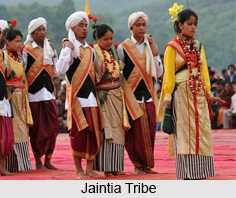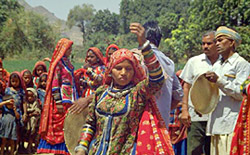Introduction
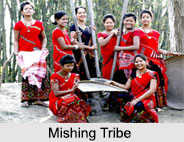 Mishing Tribes are also called "Miri" by the local people. They are mainly concentrated in nine districts of Assam - Tinsukia, Dibrugarh, Sibsagar, Jorhat, Golaghat, Darrang, Sonitpur, North-Lakhimpur and Dhemaji. They live in villages preferably on the bank of rivers in pile houses and can be easily distinguished by their dresses.
Mishing Tribes are also called "Miri" by the local people. They are mainly concentrated in nine districts of Assam - Tinsukia, Dibrugarh, Sibsagar, Jorhat, Golaghat, Darrang, Sonitpur, North-Lakhimpur and Dhemaji. They live in villages preferably on the bank of rivers in pile houses and can be easily distinguished by their dresses.
Origin of Mishing Tribes
Mishing Tribes belong to Mongoloid group of people. Linguistically they belong to Tibeto-Burman sub-family. They also speak in Assamese language. In this sense the Mishings are bilingual people. They have settled along the south western belt bordering the state of Assam.
Society of Mishing Tribes
Mishing Tribes are distributed in villages of Paglam circle and are similar in many ways to Adi tribe of Arunachal Pradesh. The Mishing consists of several loosely-knitted groups and each group consists of several clans of close blood relation. Every clan bears a particular title of surname. They practice clan-exogamy. Monogamy is the common form of marriage though polygamy is found among them. The Mishings are patriarchal and descent is in the male or father`s line. The sons inherit the family property. Cross-cousin marriage is prevalent among the Mishings. "Midang" and "Dugla-lanam" are the common forms of marriage among them.
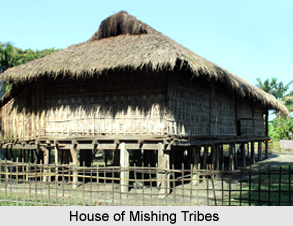 The Mishings tribes, also known as Miris, mainly reside in the north eastern region of India. During the medieval period they descended to the valleys and currently inhabit the districts of Dibrugarh, Tinsukia, Jorhat, Sibsagar, Darang, North Lakhimpur, Dhemaji, Sonipur and Golaghat. Presently the Mishings form a significant part of the tribal population. They have their separate society, dwellings, socio-religious festivals, social behaviour, dressing pattern, language, family system and language.
The Mishings tribes, also known as Miris, mainly reside in the north eastern region of India. During the medieval period they descended to the valleys and currently inhabit the districts of Dibrugarh, Tinsukia, Jorhat, Sibsagar, Darang, North Lakhimpur, Dhemaji, Sonipur and Golaghat. Presently the Mishings form a significant part of the tribal population. They have their separate society, dwellings, socio-religious festivals, social behaviour, dressing pattern, language, family system and language.
Family of Mishing Tribes
The Mishings consists of several loosely knitted groups and each group comprises of several clans of close blood relation. Every clan bears a particular title or surname. They practice clan exogamy. Monogamy is the common form of marriage though polygamy is also practised among them. The Mishings belong to the patriarchal society and the line of descent is traced through the father. The sons inherit the family property. Cross-cousin marriage is prevalent among the Mishings. The Mishing tribes generally reside in nuclear families where the husband is the head of the family and exercises authority. The head of the family maintains and exerts control over other family members. This helps in strengthening the social system. `Daglek`, `Rig Bo` are the important co-operative institutions of the Mishings. The head of the `Kebang`, the chief administrative unit is known as `Gam`.
Village House of Mishing Tribes
The Mishing Tribes usually live in small huts on the banks of rivers. The houses have an elevated platform known as `Chang ghar.` Their dwellings have thatched roofs and stilted floor generally constructed with flattened bamboo. The houses are usually built four to five feet above the ground. Affluent people built their houses with wood while others use bamboos. Houses where joint families reside are usually huge in size and have several fireplaces. In the front side of the house a portion of platform is kept open to be used as a verandah. A raised area of the house is usually extended to serve the purpose of cleaning utensils, straining of rice etc. The houses have two doors, one at the front and other at the back. Sometimes a third door is also constructed that might open to an exposed platform. The space is used for sitting, lying down and also for drying paddy grains. Presently the houses are not made according to the traditional style.
Occupation of Mishing Tribes
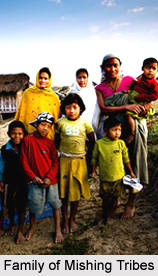 Mishing tribes are dependent on agriculture for earning their livelihood. They practice permanent cultivation though the practice of shifting cultivation has not been fully given up. The crops that are mainly grown by them are pulses, paddy, maize and mustard and varieties of vegetables. They also cultivate different varieties of rice as well. They are also considered as expert fishermen. The women of the community also contribute to the family income by rearing pigs, fowls and goats.
Mishing tribes are dependent on agriculture for earning their livelihood. They practice permanent cultivation though the practice of shifting cultivation has not been fully given up. The crops that are mainly grown by them are pulses, paddy, maize and mustard and varieties of vegetables. They also cultivate different varieties of rice as well. They are also considered as expert fishermen. The women of the community also contribute to the family income by rearing pigs, fowls and goats.
Marriage System of Mishing Tribes
The marriage system among the Mishing tribes incorporates several rites and rituals. Marriage is forbidden within the same `Gumin,` a Mishing social organisation. The Mishings follow the custom of `Magbo-dugnam` where the probable bridegroom renders service in the house of his would be bride. Songs and dances are an essential feature of Mishing marriage. Widow re-marriage is practised but child marriage is prohibited. Da:ro Midang, Kumsu-jo:su and Dugla la:nam are the three important types of marriages of the Mishings.
Funeral Rites of Mishing Tribes
The Mishings follow certain unique traditional funeral rites. They pour `Apong` or water through a conical leaf in the mouth of the dying person. They wrap the dead body first with a cloth and then with a mat and then burry them. `Ago-golung` is a burial ground of the Mishings. The family members of the deceased observe certain rituals until the purificatory rites are performed. `Usi` or `Uram-Apin` `Dodgang` are few special purificatory practises where the family members wail loudly in the presence of other people. They also sing the kaban, a song of lament.
Occupation of Mishing Tribes
Mishing people are dependent on agriculture for earning livelihood. They practice permanent cultivation though shifting cultivation has not been fully given up. The crops that are mainly grown by them are pulses, paddy, maize and mustard and varieties of vegetables.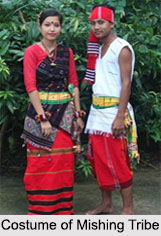 They also cultivate different varieties of rice. They are also considered as expert fishermen. Fishing is another occupation of the Mishing people. The women of the community also contribute to the family income by rearing pigs, fowls and goats.
They also cultivate different varieties of rice. They are also considered as expert fishermen. Fishing is another occupation of the Mishing people. The women of the community also contribute to the family income by rearing pigs, fowls and goats.
Religion of Mishing Tribes
The Mishing are originally animistic due to the influence of Shri Shankaradeva- the preacher and devotee of Vaishnavism in Assam. However, it has been highly influenced by the culture of Hindu religion. Some sections of the Mishing tribe have adopted Hinduism, while the others retain the indistinct religious notions of their ancestor believing in the existence of numerous malevolent and benevolent deities. Mishing people believe in the existence of supernatural beings.
Festivals of Mishing Tribes
"Ali-Aye-Ligang" and "Porag" are important festivals of the Mishing. These festivals are celebrated by special dance by boys and girls. Both these festivals are associated with cultivation. Ali-Aye-Ligang is celebrated during the month of February. They offer prayers for obtaining the blessings of the almighty for abundant crop. Porag festival is considered as a post harvest festival. It is a grand three days festival of the Mishing tribe. During the celebration of these festivals, they organise hunting expeditions and arrange grand feasts.
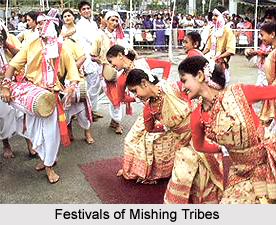 The Mishing Tribes mainly concentrated in the districts of Assam celebrate festivals associated with cultivation. The two important festivals celebrated by them are Ali-a:ye L¡gang and Porag. During the celebration, they organise hunting expeditions and arrange grand feasts. Apart from these there are several dances and festivals of the Mishing tribe. Their dances are called Paksong or Soman and it bear great similarity with the Bihu dance of Assam. Their songs also known as Niton are chiefly of three major types and these are Aku, Oi and Anu Nitone. Aku depict the history and rich culture of the people whereas Oi and Anu Nitone are contemporary love songs and use modern musical instruments. Drum, clapping metal bells and bansuri are the local instruments used by Mishing tribe. The important festivals of the Mishings have been discussed below:
The Mishing Tribes mainly concentrated in the districts of Assam celebrate festivals associated with cultivation. The two important festivals celebrated by them are Ali-a:ye L¡gang and Porag. During the celebration, they organise hunting expeditions and arrange grand feasts. Apart from these there are several dances and festivals of the Mishing tribe. Their dances are called Paksong or Soman and it bear great similarity with the Bihu dance of Assam. Their songs also known as Niton are chiefly of three major types and these are Aku, Oi and Anu Nitone. Aku depict the history and rich culture of the people whereas Oi and Anu Nitone are contemporary love songs and use modern musical instruments. Drum, clapping metal bells and bansuri are the local instruments used by Mishing tribe. The important festivals of the Mishings have been discussed below:
Ali-Aye-Ligang
Ali-Aye-Ligang is celebrated at the beginning of the agricultural production. The word Ali means `yam` and a:ye means `fruit` or `grain.` L¡gang denotes `beginning of sowing`. The festival begins with the head of the family sowing a small amount of paddy seeds. It is the ploughed with a hoe. The Mishings recite prayers for the guardian spirits as well as the ancestors. During the celebrations the feasting part includes the Purang apin, a special type of sticky rice packed in a leaf and rice beer. In the evening, young men perform dances and sing songs known as gumrag so:man in the front yard of the houses. Bell-metal gong, known as le:nong or marbang are played along with drums and cymbals at the time of singing and dancing. The drums are played according to a particular rhythm of gumrag so:man only. Ali-a:ye L¡gang is celebrated for five days. On the last day of the festival ends with feasting at homes.
Porag
The Porag festival is celebrated after a good harvest. The festival is marked by grand feasting and merry making. A lengthy preparation is required for the celebration of the festival hence it is celebrated once in two or three years. The festival starts with prayers under the guidance of a Mibu, a medicine man. When the Mibu is absent the festival is conducted under the leadership of an aged person of the village. All the members of the village are given a lavish treat. Pork is compulsory item on the menu. Apart from this po:ro apong, a rice beer of black colour made through fermentation of a mixture of burnt chaff and half cooked rice. It is a unique drink of the Mishings. The couples usually bring few youths for dancing and singing. Local dignitaries as well as eminent people from the neighbouring villages are also invited for the occassion. The festival is celebrated for three days and is accompanied by singing, dancing, feasting and merry making.
Dobur
Dobur is an animistic ritual celebrated occasionally by the Mishing Tribes. There are four types of Dobur, Mo:pun Dobur, Burte Dobur and Raban Ko:son organised by the Mishings. Burte Dobur is the most common them. It is usually practised when a member of the village commits a sin against a benevolent or malevolent spirit. The villagers believe that it might cause harm and suffering to their village hence the sinner is made to pay in cash or kind. The boys then go around the village and stroke the walls of every house with sticks to drive out the evil spirits. People who participate in this ritual assemble in a particular spot away from the village. There they sacrifice sows and hens to the spirits to appease them. Later they together have a feast. The place where the sacrifice has been done is regarded as a protected area on that particular day. Mo:pun Dobur and Raban Ko:son are observed to appease the spirits so that their crops, hens and sows remain protected. The hunters practise the Ko:son Dobur to appease jungle spirits. It is believed that it helps them in their hunting process and protects them against any harm. Hens are sacrificed during this occasion.
Culture of Mishing Tribe
There are several dances and festivals of the Mishing tribe. Their dances are called Paksong or Soman and it bear great similarity with the Bihu dance of Assam. Their songs also known as Niton are chiefly of three major types and these are Aku, Oi and Anu Nitone. Aku basically contains history and rich culture of the people whereas Oi and Anu Nitone are contemporary love songs and use modern musical instruments. Drum, clapping metal bells and bansuri are the local instruments used by Mishing tribe.
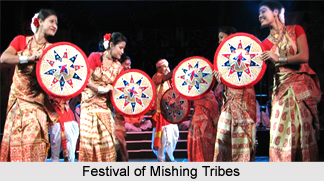 The Mishing Tribes are a part of the aboriginal tribes of the north east region in India. They presently reside in different districts of Assam like Tinsukia, Jorhat, Sibsagar, Darang, North Lakhimpur and others. The Mishings have their own culture and traditions that has been handed down from ages.
The Mishing Tribes are a part of the aboriginal tribes of the north east region in India. They presently reside in different districts of Assam like Tinsukia, Jorhat, Sibsagar, Darang, North Lakhimpur and others. The Mishings have their own culture and traditions that has been handed down from ages.
Food of Mishing Tribes
Earlier the Mishing Tribes depended on hunting for their food. With time rice along with fish and meat became their staple food. They also began consuming fruits. The Mishings also rear pig, goat, duck and eat their meat. They also eat vegetables, forest herbs and `namsing` i.e. dried and grinded fish. `Apong` a type of drink made from rice is famous among the Mishings. The drink is also offered to the guests during weddings, religious occasions, festivals, etc. Agriculture is the main source of income for them. They also cultivate mustard seeds and paddy. Fishing, hunting and animal husbandry are also practised by them.
Dress of Mishing Tribes
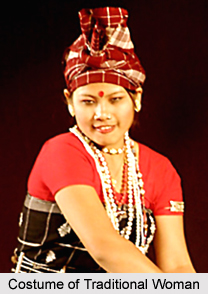 The Mishings tribes have a unique dressing style that helped them acquire a distinctive place in the state. They adorn themselves with dresses like `Gachar`, `Galuk`, `Ege`, `Ribi Gasor`, `Yakan Age-Gasar`, a black Mekela Sadar, `Gero.` These are made of different colours like `Yambo`, `lake-Ege`, `Gaseng` `Gero`, `Ribi`, etc. The men usually wear `Mibu galuk`, a shirt, `Gonro ugon`, a dhuti and `dumer` a gamucha. Females of this tribal group wear a self woven lion cloth, which is known as Gaseng. It is used for covering the lower portion of the body. The upper garment that they use is also a self-woven cloth, known as Kebbung. Beautiful shawls or Ribi Gaseng are used mainly during the winter season and in some festive occasions. Most of the Mishing women are proficient weavers who knit clothes in handloom. `Gadu` marked by its colour and composition is exclusive feature of the Mishings. These handworks of the Mishing tribes reflect their passion and proficiency that have been passed down from generations. Most of their dresses are adorned with the symbolic figure of `Do-ni-Polo.`
The Mishings tribes have a unique dressing style that helped them acquire a distinctive place in the state. They adorn themselves with dresses like `Gachar`, `Galuk`, `Ege`, `Ribi Gasor`, `Yakan Age-Gasar`, a black Mekela Sadar, `Gero.` These are made of different colours like `Yambo`, `lake-Ege`, `Gaseng` `Gero`, `Ribi`, etc. The men usually wear `Mibu galuk`, a shirt, `Gonro ugon`, a dhuti and `dumer` a gamucha. Females of this tribal group wear a self woven lion cloth, which is known as Gaseng. It is used for covering the lower portion of the body. The upper garment that they use is also a self-woven cloth, known as Kebbung. Beautiful shawls or Ribi Gaseng are used mainly during the winter season and in some festive occasions. Most of the Mishing women are proficient weavers who knit clothes in handloom. `Gadu` marked by its colour and composition is exclusive feature of the Mishings. These handworks of the Mishing tribes reflect their passion and proficiency that have been passed down from generations. Most of their dresses are adorned with the symbolic figure of `Do-ni-Polo.`
Religion of Mishing Tribes
Do-ni, the Sun and Polo, the Moon are the main god and goddess of the Mishing Tribes. Do-ni is addressed as mother and Polo as father. The Mishings believe that the gods and goddesses have been divided into two groups, malevolent and benevolent. The main priest of the Mishings is known as `Mibu.` He is the most revered person among the Mishings. It is believed that he has the ability to connect with the gods and goddess. He chants the `Abang Mantras` and sings songs about the world, men and women, animals and different powers that exist. During festivals they sacrifice chickens and pigs. They also believe in many folk beliefs such the existence of `soul Epom`, Yalo etc.
Festivals of Mishing Tribes
Festival constitutes an important part of the Mishings. `Ali-ai-ligang` is the main festival celebrated by the Mishings during the month of Phagun before the beginning of cultivation. Mother Earth is worshipped during the festival so that with her blessings there is plenty of production. The villagers during the festival wear `Ribi-gaseng`, `Mibo-galuk`, `Leke-Ege` and `Gonro-Ugon.` Another grand festival of the Mishings is the `Porag` celebrated after the crops have been harvested. The Mishings perform their traditional dances during the festive season. These are usually performed either to the tunes of musical instruments or along with their traditional songs. Some of the Mishing dance forms are `Mibu-dugnam`, `So-man` and `Ligang-sonam.` They also play different types of musical instruments such as `Gunggang`, `Dum Dum`, `Le-nang`, `Ejuk Tapung`, `Dendun`, `Tu:tok Tapung`, `Marbang`, `Jekring tapung` etc.
Folk Literature of Mishing Tribes
The folk life of the Mishing tribes contributes towards the development of their folk literature. The folk literature of the Mishings has been adopted from their `Luse-Iukor` a proverb, `Solok`, a riddle, `Do-ying` i.e. a fable and `Nitom`, different folk songs. They also have their own language. They make use of Roman scripts for imparting education and producing literature. Presently, several Mighings have adopted Vaishnavism.
Costumes of Mishing Tribe
The costumes of Mishing tribe are interesting. Male dresses are almost alike the Assamese with white dhoti as the lower garment, a white bush shirt or Kurta as the upper garment and with a turban on the head. However, these people differentiate themselves by wearing a cover coat with parallel and stripe design known as "Mibu Galuk". On the other hand, females of this tribal group wear a self-woven cloth, which is known as "Gaseng", as the lower garment retaining it on the waist and "Kebbung" as the upper garment that is covered round just below the shoulders.
Villages of Mishing Tribe
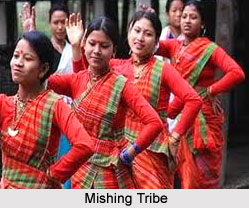 The Mishing tribes, also known as Miri by the local people, chiefly reside in the nine districts of Assam, Dibrugarh, Golaghat, Tinsukia, Sonipur, Darang, Sibsagar, Dhemagi, Jorhat and North Lakhimpur. They usually live on the banks of rivers in small huts. The Mishing tribes are scattered over a wide area and reside in different villages.
The Mishing tribes, also known as Miri by the local people, chiefly reside in the nine districts of Assam, Dibrugarh, Golaghat, Tinsukia, Sonipur, Darang, Sibsagar, Dhemagi, Jorhat and North Lakhimpur. They usually live on the banks of rivers in small huts. The Mishing tribes are scattered over a wide area and reside in different villages.
Ghagar Village
Ghagar, located along the Subansiri River in the Lakhimpur District, is almost 12 kms away from North Lakhimpur town. There are almost 65 households in this village. Each of these household presently possesses one local traditional loom. The Chang Ghar i.e. a house having an elevated platform is a conventional housing style of the Mishing tribes.
Ghunasuti Village
Ghunasuti village is at a distance of almost 16 kms from the North Lakhimpur town. One needs to ride a machine boat to cross the Subansiri River and then walk almost 4 kms to reach the village. The Subansiri River and Brahmaputra River are located on either side of the village. The Mishings residing here are highly skilled in art and craft work. Weaving is their primary craft work and the inhabitants adorn themselves with self-woven clothes. The women folk of the village are proficient at manufacturing of traditional Mishing clothes like Makhela Chaddor, Mirizim, Ribigasang, Erhee Chaddor, Galuk, Mibu, Gamucha and others.
Tajik Gaon, Gogamukh
Tajik Gaon is located at a distance of 2.5 kms from Gogamukh under the Dhemaji District. Gogamukh is located at a distance of 28 kms from Dhemaji town. It is a traditional village dominated by the Mishings. The village has a total of 260 households. The womenfolk of the village are highly skilled weavers and they remain engaged in weaving their daily household clothes like Mekhala Chaddor, Ribigasang, Erhee Chaddor, Mirizim, Gamucha, Mibu, Galuk and others. Tajik Gaon also has accommodation facilities for the tourists. A Forest Guest House has also been set up here.
Pomuwa, Gogamukh
Pomuwa is a traditional village mainly resided by the Mishing tribes. The village is almost 3 km away from Gogamukh Central and 7 km away from Bordoibam Beelmukh Birds` Sanctuary. It is well connected by road and is on the way to Dhakuwakhana. Pomuwa. It is divided into two parts Namoni Pomuwa and Ujani Pamuwa. At present the village has 200 households and every household here possesses an individual loom made of bamboo and wood. The womenfolk of the village are highly skilled weavers and engage in weaving daily traditional clothes. The village has been bestowed with the State Tribal Handloom Designer Awards in 2004.
Karichuk, Dhemaji
Karichuk, dominated by the Mishing community, is situated at a distance of 1.5 km away from Dhemaji Bus Station and is 1 km from Dhemaji Railway Station. Karichuk is situated in Dhemaji town area and has almost 300 Mishing families residing here. They are chiefly employed in the Government service yet keeping pace with the tradition every household possesses at least one loom. They manufacture their own clothes and presently they also engage in weaving clothes for commercial purpose. The village has accommodation facilities for the tourists. Popular hotels like, Main Road Dhemaji, Raj Hotel, Main Road Dhemaji, Hotel Manash, and Shikha Hotel are located here.
Bahir-Jonai, Jonai
Bahir-Jonai is situated at a distance of 4 km far away from Jonai Town. The Jonai civil sub-division is located at the north eastern corner of Dhemaji District of Assam. The village resided by Mishings is rich in art and culture. The inhabitants of the village are engaged in art and culture and specialise in weaving. The village has almost 100 households. Tourists visiting the village can put up at Jonai Circuit House; C. K. Hotel and Restaurant, Jonai Bazar or at Beauty Hotel.
Ratanpur, Jonai
Ratanpur, resided by the Mishing tribes is situated on the northern bank of Brahamputra River. It is located at a distance of 5 kms from Jonai town. Almost 65 families reside in this village. Every household here upholds the tradition of weaving. Young girls as well as the women of the village are highly skilled in the art of weaving various types of colourful dresses. Most villagers here are function independently and weave their own daily required garments like Makhela, Mibu Galuk, Erhi chador, Ri:bi:gasang, Chadder, Gamucha etc.
Crafts of Mishing Tribe
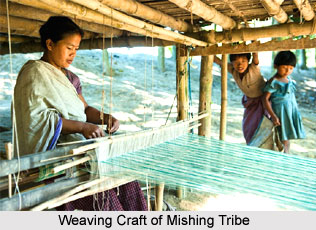 The Mishing tribes also known as Miri by the local people, have mainly settled along the south western belt bordering Assam. They are a part of Mongoloid group of people and consist of several loosely knitted groups. The main source of income of the Mishings is agriculture. They also practise shifting cultivation. The weaving industry represents the traditional legacy of the Mishings. The array of items woven depicts the artistic mastery of the craftsmen.
The Mishing tribes also known as Miri by the local people, have mainly settled along the south western belt bordering Assam. They are a part of Mongoloid group of people and consist of several loosely knitted groups. The main source of income of the Mishings is agriculture. They also practise shifting cultivation. The weaving industry represents the traditional legacy of the Mishings. The array of items woven depicts the artistic mastery of the craftsmen.
Designs of Weaving Crafts of Mishing Tribe
The Mishings are engaged in nurturing the weaving craft since time immemorial. The typical usage of designs, unique colour combinations and selection of motif prominently characterize the Mishing clothes. Among the Mishings it is compulsory to dress in self woven clothes during the weddings. Priority is mostly given to bright vivid colours and the clothes are exclusively designed using different colour threads like orange, yellow, green, black and red. The dress materials consist of specific designs of nature, trees, sceneries, group of flying birds, sprays of towers, various geometrical patterns, stars and others. These people have also preserved their rich traditional textile motifs. Special designs and motifs have also been borrowed from the neighbouring communities and well implemented. The local craftsmen usually design the traditional clothes using floral patterns, images of animals like elephants inter-spread with lions, deer, horses, leaves, birds and spring. Traditional motifs like fish, cons and crossed swords, etc. are also employed. The Mishing textiles also use motifs on white, black or other background colours thus, providing them with an exotic look and style. The bird motifs are usually kept in red and white colour. They are mostly triangular in shapes and rhythmically follow a triangular pattern. In comparison to the men`s garments the style, colour combination and design of women`s garments are more intense and brighter. The Mishings have their own traditional techniques of colouring the designing threads. The womenfolk are proficient in the use of simple handlooms for weaving their clothes.
Mirizim is one of the most striking and exotic kind of shawl or blanket of the Mishing community. It is regarded as impressive and precious wedding gift for the newly wed. The mother usually presents a self-woven blanket to the new bride. The womenfolk mostly practise the household tradition of weaving of mirizim that requires a lot of effort and labour. Raw cotton fabrics are used for weaving it. At the first stage the cottonseeds are extracted from cotton and then it is dried. Following this fine threads are spun out in the form of thin cord. These fine threads are then spun with hand spindles and no spinning wheel is used in the entire process. The weaving is done on the simple local loom. Finally it is made into a long lasting blanket that serves as a warm cover during the winter months.

